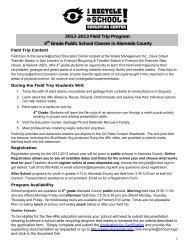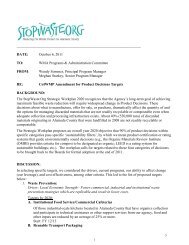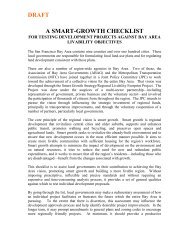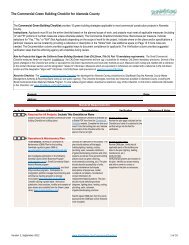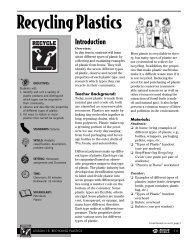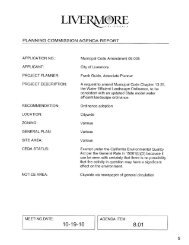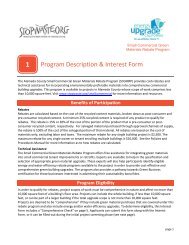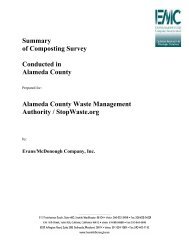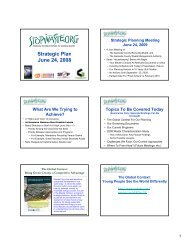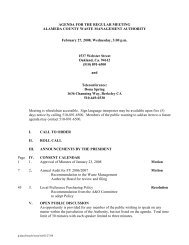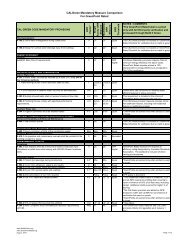Bay-Friendly Landscaping Principles and Practices - StopWaste.org
Bay-Friendly Landscaping Principles and Practices - StopWaste.org
Bay-Friendly Landscaping Principles and Practices - StopWaste.org
Create successful ePaper yourself
Turn your PDF publications into a flip-book with our unique Google optimized e-Paper software.
<strong>Principles</strong><br />
& <strong>Practices</strong><br />
photo: Richrad rollins<br />
8. Manage <strong>and</strong> maintain the<br />
irrigation system carefully<br />
Description<br />
A poorly maintained irrigation system<br />
wastes water, adds to surface runoff, <strong>and</strong><br />
damages property.<br />
Applications<br />
n Match watering schedule to plant<br />
needs, soil type, slope <strong>and</strong> season.<br />
n Eliminate leaks <strong>and</strong> spraying onto<br />
sidewalks immediately.<br />
n Install rain shut-off devices.<br />
n Upgrade to new technology irrigation<br />
controllers that adjust watering<br />
schedules to reflect weather<br />
conditions or soil moisture <strong>and</strong> include<br />
a rain shut-off device.<br />
n Refer to applications in the section<br />
Conserve Water.<br />
Benefits<br />
Water will be conserved, runoff reduced<br />
<strong>and</strong> your customer may save money<br />
on water bills, while protecting the San<br />
Francisco <strong>Bay</strong> watershed.<br />
9. Design a system to capture <strong>and</strong> treat water<br />
Description<br />
Catching, slowing <strong>and</strong> retaining water<br />
will promote infiltration <strong>and</strong> removal<br />
of pollutants, as well as minimize<br />
stormwater runoff. It can also add beauty<br />
<strong>and</strong> value to the l<strong>and</strong>scape. Studies<br />
indicate that home values <strong>and</strong> leases of<br />
commercial buildings are higher if the<br />
building overlooks, or the home is within<br />
300 feet of a water element.<br />
Applications<br />
n Limit grading to protect existing<br />
patterns of drainage <strong>and</strong> retain natural<br />
topographic features that slow <strong>and</strong><br />
store storm flows.<br />
n Incorporate design measures <strong>and</strong><br />
treatment controls, such as l<strong>and</strong>scape<br />
beds, detention basins, ponds,<br />
stormwater wetl<strong>and</strong>s <strong>and</strong>/or vegetated<br />
swales, that are sized to treat at least<br />
85% of average annual runoff.<br />
n Divert rain water from all down spouts<br />
to planters, swales or l<strong>and</strong>scaped<br />
areas. Capture <strong>and</strong> filter runoff from<br />
parking lots into isl<strong>and</strong>s or planter<br />
strips or other treatment controls.<br />
Rain is directed into l<strong>and</strong>scape beds.<br />
Rock cobble around stormdrains<br />
prevents mulch from entering the<br />
drain.<br />
n Design bioswales with flat bottoms of<br />
at least 18 inches across, <strong>and</strong>/or rock<br />
cobble at points of concentrated flow.<br />
n Specify turf alternatives for bioswales.<br />
n Plant a 24 inch buffer zone between<br />
areas receiving spray irrigation <strong>and</strong><br />
impervious surfaces to keep over spray<br />
<strong>and</strong> runoff out of stormdrains.<br />
Benefits<br />
Stormwater runoff is reduced while water<br />
recycled on site fosters the removal of<br />
pollutants <strong>and</strong> encourages biodiversity.<br />
Downstream engineering costs are<br />
decreased. Property values can be<br />
increased.<br />
Site water flows to a bioswale, enhancing<br />
on-site infiltration <strong>and</strong> reducing<br />
contaminants.<br />
photo: Richrad rollins<br />
Tips for Success<br />
Using Dry Wells to Capture Water from Downspouts<br />
Directing roof runoff to dry wells is a good way to reduce the amount of potable water used for l<strong>and</strong>scape irrigation. Use<br />
of dry wells can improve stormwater quality, increase groundwater recharge, decrease runoff volume <strong>and</strong> peak flows, <strong>and</strong><br />
decrease flooding potential. The captured water can be reused for watering gardens, lawns <strong>and</strong> trees. To construct a dry well,<br />
dig a hole in the ground — sized according to the amount of rooftop runoff received (typically 4 to 5 feet square <strong>and</strong> 2 to 3<br />
feet deep, with a minimum of 1 foot soil on top) — <strong>and</strong> fill with an open graded aggregate. The roof downspout is directed<br />
to the dry well which allows the water to infiltrate after a storm. Dry wells must be located at least 10 feet from any building<br />
to protect the foundation. Dry wells are less effective in soils with poor drainage. For more information, see “Roof Runoff<br />
Controls, SD-11,” from the 2003 California Stormwater BMP H<strong>and</strong>book: New Development <strong>and</strong> Redevelopment,<br />
www.cabmph<strong>and</strong>books.com.<br />
48<br />
3



